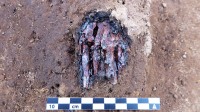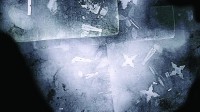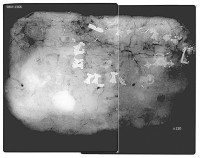 Archaeologists excavating the Fregerslev Viking grave south of Hørning near Skanderborg in Jutland, Denmark, have discovered a bundle of arrowheads at the bottom of the grave. The bundle appears to contain six heart-shaped iron arrowheads. There’s a layer of black organic material at the pointed end of the arrowheads that archaeologists believe to be the remnants of the quiver, long-since decayed.
Archaeologists excavating the Fregerslev Viking grave south of Hørning near Skanderborg in Jutland, Denmark, have discovered a bundle of arrowheads at the bottom of the grave. The bundle appears to contain six heart-shaped iron arrowheads. There’s a layer of black organic material at the pointed end of the arrowheads that archaeologists believe to be the remnants of the quiver, long-since decayed.
These were probably not weapons of war. They were likely used for hunting deer and wild boar. It’s even more evidence of what an elevated position the Fregerslev Viking held in society. Only the elite would have had the opportunity and means to go hunting, so the bundle of arrows buried with him are symbols of high status.
 Arrowheads are very rare discoveries in Viking rider graves. A whole quiver of them is practically unheard of, and the Skanderborg Museum archaeologists are justifiably elated by the find. As with the other rich discoveries in the grave, the arrowheads were not fully excavated in situ. They were removed in a soil block earlier this week and taken to the museum laboratory to be X-rayed. The X-ray should show archaeologists how many arrows are in the bundle and give them a roadmap for excavation of the block in the lab.
Arrowheads are very rare discoveries in Viking rider graves. A whole quiver of them is practically unheard of, and the Skanderborg Museum archaeologists are justifiably elated by the find. As with the other rich discoveries in the grave, the arrowheads were not fully excavated in situ. They were removed in a soil block earlier this week and taken to the museum laboratory to be X-rayed. The X-ray should show archaeologists how many arrows are in the bundle and give them a roadmap for excavation of the block in the lab.
Reaching the bottom of the rider’s grave is an important milestone. It’s only 28 centimeters (11 inches) deep at the deepest point — it’s a miracle that it wasn’t destroyed by agricultural activity — but the sheer amount of corrosion from metals including gold, bronze and silver visible on the surface of the trench indicates there are still an extraordinary number of expensive grave goods under there.
 Experts are still in the process of X-raying the soil blocks that have already been removed. One lifted from the foot of the grave near the block that was already found to contain star-shaped bridle fittings contains even more fittings. The ones showing as bright white in the X-ray are silver or silver-plated. There are new types of hardware in the block that archaeologists believe to be decorative elements from a harness and/or stirrups. There is no sign of the stirrups themselves, however, which the team are keen to find. They hope excavation and X-rays of other soil blocks will find evidence of the stirrups.
Experts are still in the process of X-raying the soil blocks that have already been removed. One lifted from the foot of the grave near the block that was already found to contain star-shaped bridle fittings contains even more fittings. The ones showing as bright white in the X-ray are silver or silver-plated. There are new types of hardware in the block that archaeologists believe to be decorative elements from a harness and/or stirrups. There is no sign of the stirrups themselves, however, which the team are keen to find. They hope excavation and X-rays of other soil blocks will find evidence of the stirrups.
The shiny things aren’t the only archaeological treasures in the grave. Archaeologists will be using the latest and greatest technology to analyze the soil for microscopic remains that will allow them to identify species of plants that were once inside the grave but have decayed along with the human and horse remains. They’re also going to look for DNA in the soil. German archaeologists have recently had a breakthrough in this cutting-edge technology, successfully isolating prehistoric DNA from the soil and clay of caves with nary a bone or tooth in sight.